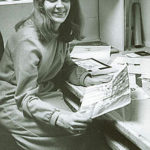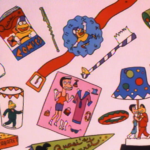Sally Cruikshank
Vimeo channel:https://vimeo.com/user33095466
Bio from Wikipedia:
Sarah “Sally” Cruikshank (born June 1949) is an American cartoonist and animator whose work includes animation for the Children’s Television Workshop program Sesame Street, and whose short “Quasi at the Quackadero” (1975) was inducted into the United States National Film Registry.
Early life and education
Sally Cruikshank was born in Chatham, New Jersey, the daughter of parents Rose and Ernest. Her parents were both Southerners, with her father, an accountant who worked in nearby New York City, New York, holding a Phi Beta Kappa key from Duke University, in North Carolina. Ernest’s mother had been the president of the boarding school formerly known as St. Mary’s College in that state. Cruikshank has a brother, and had a sister, Carol, who died in 1991. Their maternal aunt, Bea, was a painter from the 1910s to the 1940s, whose work included a portrait commission by US President Franklin Delano Roosevelt. Cruikshank studied art at Smith College, where in her junior year art teacher Elliot Offner sent slides of her colored-pencil and clay-relief-on-paper drawings to a screening committee that resulted in a scholarship to the two-month Yale Summer Art School. At the urging of a classmate there, Warner Wada, she began considering adapting her drawing style to animation. Returning to Smith for her senior year and obtaining the primer Animation by Preston Blair, Cruikshank, with additional research, arranged for a special-studies class in animation. With an animation stand consisting of a Bolex camera attached to a photo enlarger, constructed by instructor David Batchelder, she produced her first animated short, the three-minute, 16mm “Ducky”. Done with watercolor and paper animation, it starred a prototype version of her future recurring character Quasi, which one writer characterized as “an infantile duck with buck front teeth, thick glasses and a red cape.” Cruikshank, describing her anthropomorphic characters, said, “My ducks are based on the ducks from Carl Barks’ comics. But I guess they got twisted in memory, because people don’t seem to see much similarity between them.”
Encouraged by the response of “Ducky,” Cruikshank, after graduation, enrolled at the San Francisco Art Institute, in San Francisco, California, to study filmmaking. Under instructor Larry Jordan, she made the five-minute animated short “Fun on Mars” (1971), which utilized watercolor, crayon markers on paper, cutouts, and collage. Produced for $100, it also featured early versions of her trademark duck-creatures. Her next short, “Chow Fun” (1972), created with a $400 grant secured in association with PBS, mixed paper animation and cutouts glued onto animation cels.
Later work and life
Cruikshank evolved a recognizable style with surrealistic and psychedelic elements. Her film “Face Like a Frog” (1987) bears a musical score by Oingo Boingo, with the group’s Danny Elfman singing his song “Don’t Go in the Basement.”
Cruikshank has contributed animation sequences to feature films, including Twilight Zone: The Movie (1983) and Top Secret! (1984), as well as the opening title sequences to Ruthless People (1986), Mannequin (1987), Loverboy (1989), Madhouse (1990), and Smiley Face (2007). She has also worked in commercials and website design. Cruikshank also animated and produced many music videos for Sesame Street from 1989-1999.
For a short time in the 1990s, Cruikshank was employed by the Palo Alto laboratory and technology incubator Interval Research Corporation as an animator.
Cruikshank is in the process, as of 2011, of transferring her works into 35mm film format, for archival purposes, In October 2012, several 35mm prints of her work were screened at the Museum of Modern Art.
Personal life
Cruikshank was in a decade-long common-law marriage with underground cartoonist Kim Deitch during the period 1971–c. 1982. On March 17, 1984, she married producer Jon Davison, with whom she has a daughter, Dinah.
Influences and style
Cruikshank prefers the early New York City animation of such producers as the Fleischer Studios and the Van Beuren Studios, as well as early Bob Clampett. In a 1981 interview, she said of her own style at the time,
“I think I have a different concept of motion than most other animators. One thing that bothers me about so many contemporary animators is that they’ve learned a language from other animators. You see the same hand movements, the same ‘blink’ ‘blink’ ‘blink’ when a character asks a question. Too many animators don’t try to picture the dynamics of movement, to use it creatively. I’m not that great an animator per se, but I do think I have a sense of motion that makes for an offbeat view of the world.”



Comments are closed.